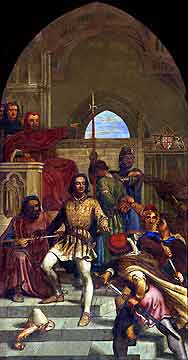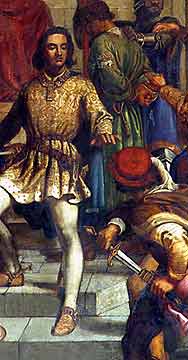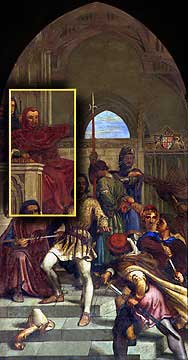Prince Henry admitting the authority of Judge Gascoigne
© 2007
Armchair Travel Co. Ltd. - This page may be used for non-commercial purposes
ONLY!
![]()

[ Play
Narrated and Animated Movie ! ] In the foreground on the steps is Henry, Prince of Wales - the Prince Hal of Shakespeare's Henry IV parts 1 and 2, and later Henry V in his own right. He is restraining one of his followers from drawing sword against a judgement which has just been made against him by the man seated at the left-hand side. The time is the early 15th century.
Sir William Gascoigne, Chief Justice to the King's Bench to Henry IV, was an historical figure, though this story of his bravery against the heir to the throne has the status of a legend rather than an historical fact. It was a favourite story of the 16th century, and was taken to show Gascoigne's indifference to his own interests, when it came to maintaining the independence of his office.
The picture is set here to exemplify the Spirit of Justice, and is paired with Daniel Maclise's fresco of the same title at the opposite end of the Chamber.
In comparison to those in the Robing Room or the Royal Gallery the mural paintings in the Lord's Chamber are, if anything, recessive rather than dominant. It has been hard for them to compete with the craftsmanship of Pugin's interior details, in particualr the maginificance of the throne.
At the time of the commission Victorian historians were looking back to the Middle Ages and their teaching proclaimed the virtues of the 'High Middle Ages'. The commissioning body chose subject matter which therefore extolled such virtues which the Victorian Age sought in its society: justice, religion and chivalry. Three frescoes directly represent these, whilst in the other three these virtues are expressed in historical narrative. In one, Prince Henry encounters the meaning of justice; in another, King Ethelbert is baptised into the Church in recognition of religion; and Edward III expresses the spirit of chivalry by founding the Order of the Garter, and making his son a knight.
[ Virtual
Tour ] [ Main Topics
Index ]




Additional Information on
Prince Henry admitting the authority of Judge Gascoigne
Explore-Parliament.net: Advanced Category Search
Keyword Categories:
_Setting_England
_Object_Painting
_Object_Artwork
_Event_Literary
_Artist_Cope
_King
_Royal_Family
_Man
_Person
_Henry_V_